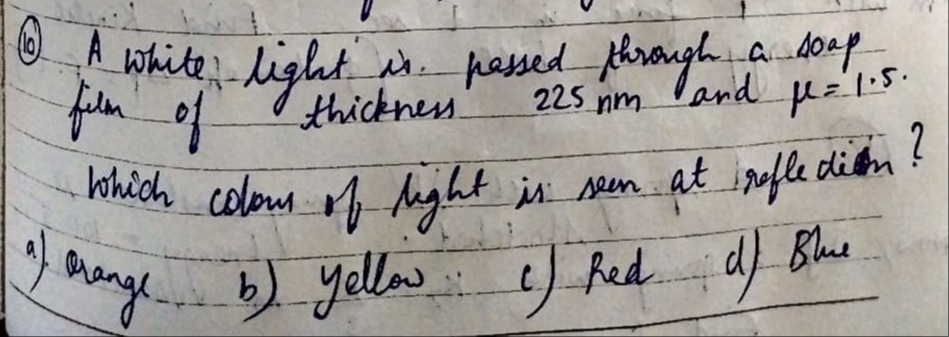Question
Question: A white light is passed through a soap film of thickness 225 nm and $\mu=1.5$. Which colour of light...
A white light is passed through a soap film of thickness 225 nm and μ=1.5. Which colour of light is seen at reflection?

orange
yellow
Red
Blue
Blue
Solution
The phenomenon observed is thin-film interference. When white light is incident on a thin film, light reflected from the top surface interferes with light reflected from the bottom surface.
Here's a breakdown of the conditions for constructive interference (bright reflection) in a thin film in air:
-
Reflections and Phase Changes:
- Light reflecting from the top surface (air to soap film): Since the soap film (μ=1.5) is optically denser than air (μ≈1), a phase change of π radians (or λ/2) occurs upon reflection.
- Light reflecting from the bottom surface (soap film to air): Since air is optically rarer than the soap film, no phase change occurs upon reflection.
-
Optical Path Difference (OPD): The light ray that enters the film travels an extra distance of 2t within the film, where t is the thickness. The optical path difference is 2μt, where μ is the refractive index of the film.
-
Condition for Constructive Interference (Bright Reflection):
For constructive interference of the reflected light, the total phase difference between the two reflected rays must be an even multiple of π. Considering the π phase change at the top surface reflection and the optical path difference, the condition is:
2μt=(m+1/2)λ
where:
- μ is the refractive index of the film.
- t is the thickness of the film.
- λ is the wavelength of light in air.
- m is an integer (0,1,2,...) representing the order of interference.
Given values:
- Thickness of the soap film, t=225 nm
- Refractive index of the soap film, μ=1.5
Calculation:
First, calculate the value of 2μt:
2μt=2×1.5×225 nm=3×225 nm=675 nm
Now, substitute this into the constructive interference equation:
675 nm=(m+1/2)λ
We need to find the wavelength λ that falls within the visible spectrum (approximately 400 nm to 750 nm) for different integer values of m:
-
For m=0:
675=(0+1/2)λ
675=0.5λ
λ=0.5675=1350 nm (This is in the infrared region, not visible)
-
For m=1:
675=(1+1/2)λ
675=1.5λ
λ=1.5675=450 nm (This is in the visible spectrum)
-
For m=2:
675=(2+1/2)λ
675=2.5λ
λ=2.5675=270 nm (This is in the ultraviolet region, not visible)
The only visible wavelength that undergoes constructive interference (and is therefore seen) is 450 nm.
The visible spectrum ranges are approximately:
- Violet: 400-450 nm
- Blue: 450-495 nm
- Green: 495-570 nm
- Yellow: 570-590 nm
- Orange: 590-620 nm
- Red: 620-750 nm
A wavelength of 450 nm corresponds to Blue light.
